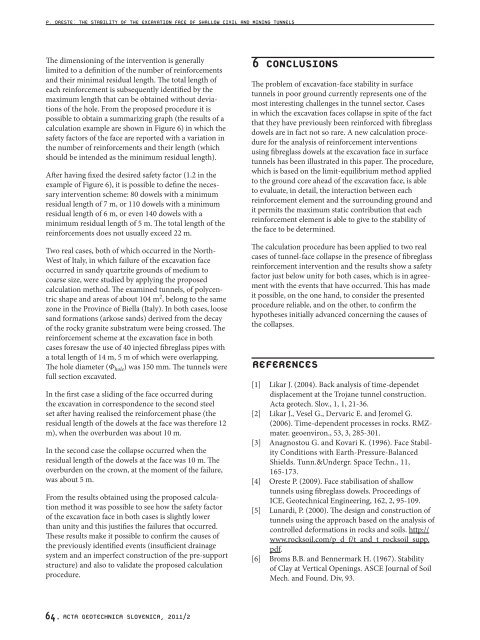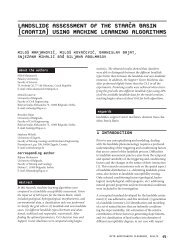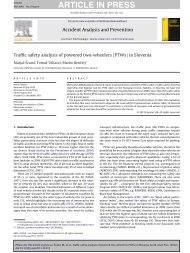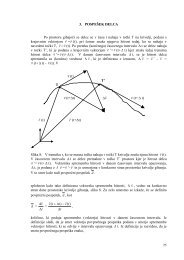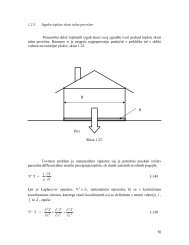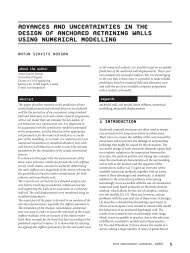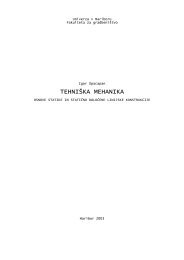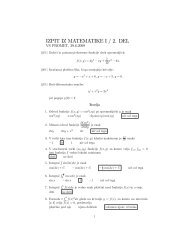The stability of the excavation face of shallow civil and mining tunnels
The stability of the excavation face of shallow civil and mining tunnels
The stability of the excavation face of shallow civil and mining tunnels
Create successful ePaper yourself
Turn your PDF publications into a flip-book with our unique Google optimized e-Paper software.
P. ORESTE: THE STABILITY OF THE EXCAVATION FACE OF SHALLOW CIVIL AND MINING TUNNELS<br />
<strong>The</strong> dimensioning <strong>of</strong> <strong>the</strong> intervention is generally<br />
limited to a definition <strong>of</strong> <strong>the</strong> number <strong>of</strong> reinforcements<br />
<strong>and</strong> <strong>the</strong>ir minimal residual length. <strong>The</strong> total length <strong>of</strong><br />
each reinforcement is subsequently identified by <strong>the</strong><br />
maximum length that can be obtained without deviations<br />
<strong>of</strong> <strong>the</strong> hole. From <strong>the</strong> proposed procedure it is<br />
possible to obtain a summarizing graph (<strong>the</strong> results <strong>of</strong> a<br />
calculation example are shown in Figure 6) in which <strong>the</strong><br />
safety factors <strong>of</strong> <strong>the</strong> <strong>face</strong> are reported with a variation in<br />
<strong>the</strong> number <strong>of</strong> reinforcements <strong>and</strong> <strong>the</strong>ir length (which<br />
should be intended as <strong>the</strong> minimum residual length).<br />
After having fixed <strong>the</strong> desired safety factor (1.2 in <strong>the</strong><br />
example <strong>of</strong> Figure 6), it is possible to define <strong>the</strong> necessary<br />
intervention scheme: 80 dowels with a minimum<br />
residual length <strong>of</strong> 7 m, or 110 dowels with a minimum<br />
residual length <strong>of</strong> 6 m, or even 140 dowels with a<br />
minimum residual length <strong>of</strong> 5 m. <strong>The</strong> total length <strong>of</strong> <strong>the</strong><br />
reinforcements does not usually exceed 22 m.<br />
Two real cases, both <strong>of</strong> which occurred in <strong>the</strong> North-<br />
West <strong>of</strong> Italy, in which failure <strong>of</strong> <strong>the</strong> <strong>excavation</strong> <strong>face</strong><br />
occurred in s<strong>and</strong>y quartzite grounds <strong>of</strong> medium to<br />
coarse size, were studied by applying <strong>the</strong> proposed<br />
calculation method. <strong>The</strong> examined <strong>tunnels</strong>, <strong>of</strong> polycentric<br />
shape <strong>and</strong> areas <strong>of</strong> about 104 m 2 , belong to <strong>the</strong> same<br />
zone in <strong>the</strong> Province <strong>of</strong> Biella (Italy). In both cases, loose<br />
s<strong>and</strong> formations (arkose s<strong>and</strong>s) derived from <strong>the</strong> decay<br />
<strong>of</strong> <strong>the</strong> rocky granite substratum were being crossed. <strong>The</strong><br />
reinforcement scheme at <strong>the</strong> <strong>excavation</strong> <strong>face</strong> in both<br />
cases foresaw <strong>the</strong> use <strong>of</strong> 40 injected fibreglass pipes with<br />
a total length <strong>of</strong> 14 m, 5 m <strong>of</strong> which were overlapping.<br />
<strong>The</strong> hole diameter (Ф hole) was 150 mm. <strong>The</strong> <strong>tunnels</strong> were<br />
full section excavated.<br />
In <strong>the</strong> first case a sliding <strong>of</strong> <strong>the</strong> <strong>face</strong> occurred during<br />
<strong>the</strong> <strong>excavation</strong> in correspondence to <strong>the</strong> second steel<br />
set after having realised <strong>the</strong> reinforcement phase (<strong>the</strong><br />
residual length <strong>of</strong> <strong>the</strong> dowels at <strong>the</strong> <strong>face</strong> was <strong>the</strong>refore 12<br />
m), when <strong>the</strong> overburden was about 10 m.<br />
In <strong>the</strong> second case <strong>the</strong> collapse occurred when <strong>the</strong><br />
residual length <strong>of</strong> <strong>the</strong> dowels at <strong>the</strong> <strong>face</strong> was 10 m. <strong>The</strong><br />
overburden on <strong>the</strong> crown, at <strong>the</strong> moment <strong>of</strong> <strong>the</strong> failure,<br />
was about 5 m.<br />
From <strong>the</strong> results obtained using <strong>the</strong> proposed calculation<br />
method it was possible to see how <strong>the</strong> safety factor<br />
<strong>of</strong> <strong>the</strong> <strong>excavation</strong> <strong>face</strong> in both cases is slightly lower<br />
than unity <strong>and</strong> this justifies <strong>the</strong> failures that occurred.<br />
<strong>The</strong>se results make it possible to confirm <strong>the</strong> causes <strong>of</strong><br />
<strong>the</strong> previously identified events (insufficient drainage<br />
system <strong>and</strong> an imperfect construction <strong>of</strong> <strong>the</strong> pre-support<br />
structure) <strong>and</strong> also to validate <strong>the</strong> proposed calculation<br />
procedure.<br />
64. ACTA GEOTECHNICA SLOVENICA, 2011/2<br />
6 CONCLUSIONS<br />
<strong>The</strong> problem <strong>of</strong> <strong>excavation</strong>-<strong>face</strong> <strong>stability</strong> in sur<strong>face</strong><br />
<strong>tunnels</strong> in poor ground currently represents one <strong>of</strong> <strong>the</strong><br />
most interesting challenges in <strong>the</strong> tunnel sector. Cases<br />
in which <strong>the</strong> <strong>excavation</strong> <strong>face</strong>s collapse in spite <strong>of</strong> <strong>the</strong> fact<br />
that <strong>the</strong>y have previously been reinforced with fibreglass<br />
dowels are in fact not so rare. A new calculation procedure<br />
for <strong>the</strong> analysis <strong>of</strong> reinforcement interventions<br />
using fibreglass dowels at <strong>the</strong> <strong>excavation</strong> <strong>face</strong> in sur<strong>face</strong><br />
<strong>tunnels</strong> has been illustrated in this paper. <strong>The</strong> procedure,<br />
which is based on <strong>the</strong> limit-equilibrium method applied<br />
to <strong>the</strong> ground core ahead <strong>of</strong> <strong>the</strong> <strong>excavation</strong> <strong>face</strong>, is able<br />
to evaluate, in detail, <strong>the</strong> interaction between each<br />
reinforcement element <strong>and</strong> <strong>the</strong> surrounding ground <strong>and</strong><br />
it permits <strong>the</strong> maximum static contribution that each<br />
reinforcement element is able to give to <strong>the</strong> <strong>stability</strong> <strong>of</strong><br />
<strong>the</strong> <strong>face</strong> to be determined.<br />
<strong>The</strong> calculation procedure has been applied to two real<br />
cases <strong>of</strong> tunnel-<strong>face</strong> collapse in <strong>the</strong> presence <strong>of</strong> fibreglass<br />
reinforcement intervention <strong>and</strong> <strong>the</strong> results show a safety<br />
factor just below unity for both cases, which is in agreement<br />
with <strong>the</strong> events that have occurred. This has made<br />
it possible, on <strong>the</strong> one h<strong>and</strong>, to consider <strong>the</strong> presented<br />
procedure reliable, <strong>and</strong> on <strong>the</strong> o<strong>the</strong>r, to confirm <strong>the</strong><br />
hypo<strong>the</strong>ses initially advanced concerning <strong>the</strong> causes <strong>of</strong><br />
<strong>the</strong> collapses.<br />
REFERENCES<br />
[1] Likar J. (2004). Back analysis <strong>of</strong> time-dependet<br />
displacement at <strong>the</strong> Trojane tunnel construction.<br />
Acta geotech. Slov., 1, 1, 21-36.<br />
[2] Likar J., Vesel G., Dervaric E. <strong>and</strong> Jeromel G.<br />
(2006). Time-dependent processes in rocks. RMZmater.<br />
geoenviron., 53, 3, 285-301.<br />
[3] Anagnostou G. <strong>and</strong> Kovari K. (1996). Face Stability<br />
Conditions with Earth-Pressure-Balanced<br />
Shields. Tunn.&Undergr. Space Techn., 11,<br />
165-173.<br />
[4] Oreste P. (2009). Face stabilisation <strong>of</strong> <strong>shallow</strong><br />
<strong>tunnels</strong> using fibreglass dowels. Proceedings <strong>of</strong><br />
ICE, Geotechnical Engineering, 162, 2, 95-109.<br />
[5] Lunardi, P. (2000). <strong>The</strong> design <strong>and</strong> construction <strong>of</strong><br />
<strong>tunnels</strong> using <strong>the</strong> approach based on <strong>the</strong> analysis <strong>of</strong><br />
controlled deformations in rocks <strong>and</strong> soils. http://<br />
www.rocksoil.com/p_d_f/t_<strong>and</strong>_t_rocksoil_supp.<br />
pdf.<br />
[6] Broms B.B. <strong>and</strong> Bennermark H. (1967). Stability<br />
<strong>of</strong> Clay at Vertical Openings. ASCE Journal <strong>of</strong> Soil<br />
Mech. <strong>and</strong> Found. Div, 93.


